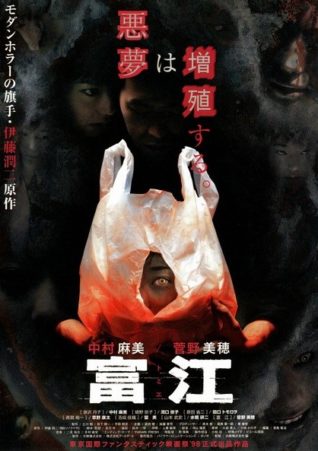 A popular, heavily sequalized Japanese horror-fest, one of several to follow in the wake of the phenomenally successful RINGU. That film’s influence is evident in TOMIE, which deals with the consequences of a horrific past event, featuring many ghostly occurrences and the eternal horror Asian moviemakers seem to feel for women with long black hair.
A popular, heavily sequalized Japanese horror-fest, one of several to follow in the wake of the phenomenally successful RINGU. That film’s influence is evident in TOMIE, which deals with the consequences of a horrific past event, featuring many ghostly occurrences and the eternal horror Asian moviemakers seem to feel for women with long black hair.
TOMIE (1998) was based on a widely read manga by Juni Ito (creator of the far more original graphic novel/movie UZUMAKI), his first published work (which is evident). The film featured several veteran genre performers in the cast, including Tomoro Taguchi (from TETSUO: THE IRON MAN), Miho Kanno (HYPNOSIS) and Kenji Mizuhashi (KAIRO), and met with a fair amount of success in its native Japan. The film’s inevitable succession of sequels and remakes is nearly as complex as that of RINGU’S notoriously convoluted lineage: in addition to a quickie made-for-TV remake called TOMIE: ANOTHER FACE (1999), it spawned the follow-ups TOMIE: REPLAY (2000), TOMIE: REBIRTH (2001), TOMIE: BEGINNING (2005) and TOMIE: REVENGE (2005) as well as TOMIE: THE FINAL CHAPTER (2002).
A man discovers an errant bag on a sidewalk one day; peeking inside, he’s shocked to find an eyeball staring back. He takes the bag, with its humanoid thing within, home. There he feeds the creature, which quickly sprouts into a teenaged girl with (gasp!) long black hair.
Around the same time a traumatized young woman named Tsukiko is being treated for memory loss. Two years earlier she was involved in a horrific accident involving several classmates that somehow claimed the life of one of them, a girl named Tomie. Tsukiko’s attractive female psychiatrist delves into her buried memories via hypnosis, not liking what she finds: it seems Tomie had a strange effect on everyone she came into contact with, and that Tsukiko and her friends dubbed Tomie a “Demon Girl”.
Meanwhile the teenaged girl who grew from the thing in the box—who, as you might have guessed, is Tomie reincarnated—has taken a job as a waitress in a classy restaurant, where she’s driving all the male staffers mad. Around the same time several suspicious deaths are uncovered, all connected in some way to Tomie.
Tsukiko suffers an injury and is confined to a hospital, where Tomie approaches and forces Tsukiko to confront the buried secret she previously couldn’t remember: she and her friends actively participated in Tomie’s brutal murder. But now Tomie is back to avenge her killing, and, as Tsukiko is about to discover, will not die!
As one who normally admires the deliberate pacing of Asian horror fests (usually a welcome break from the music video-inspired cutting of so many Hollywood flicks), I’ll have to admit I found TOMIE a bit too slow for its own good. This is one of the few movies you can watch on permanent fast forward and still get the same effect as you would without it—well, maybe: director Ataru Oikawa does manage to work up a fairly creepy atmosphere, often by simply holding on seemingly banal shots for interminable periods of time.
That doesn’t change the fact, however, that the story contains little that’s fresh or unpredictable, especially if you’ve seen the abovementioned RINGU or any of its innumerable offspring. Also, the long black hair business for me got old long, long ago. Nobody appears to have told Oikawa, though, as he milks it for all its worth, photographing the unearthly title character more often than not from the back, so we can shiver at the sight of her black locks—or at least, maybe you can. As for me, I’ll do my shivering elsewhere.
Vital Statistics
TOMIE
Daiei Pictures, Inc.
Director: Ataru Oikawa
Producers: Tsutomu Tsuchikawa, Mikihiko Hirata, Junichi Matsushita, Ken Takeuchi
Screenplay: Ataru Oikawa
Cinematography: Kazuhiro Suzuki
Cast: Mami Nakamura, Yoriko Douguchi, Kouta Kusano, Tomoro Taguchi, Miho Kanno
